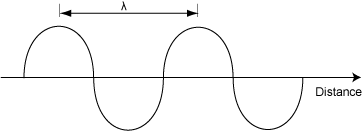Electromagnetic radiation has an electric field component and a magnetic field component. The electric and magnetic fields oscillate sinusoidally, perpendicular to each other and perpendicular to the direction the wave is travelling. Since the oscillations are perpendicular to the direction of the wave, electromagnetic radiation is a transverse wave.
In the diagram below, showing an electromagnetic wave travelling from left to right, the electric field is oscillating up and down, and the magnetic field is oscillating perpendicular to the page.

Two important properties of waves are:
- wavelength (λ)
- frequency (f)
Wavelength
The wavelength is the distance over which the wave repeats itself. That is, it is the distance between one crest and the next crest of the wave, or the distance between two adjacent valleys. The symbol for wavelength is the Greek letter lambda, λ.

The S.I. unit for wavelength is metres. Wavelengths of visible light are often expressed in nanometres.
Frequency
The frequency of a wave is the number of cycles that are completed per second. It can also be thought of as the number of wavelengths that pass a certain point per second. The symbol for frequency is f.
The S.I. units of frequency are Hertz (Hz).
1 Hz = 1 s-1